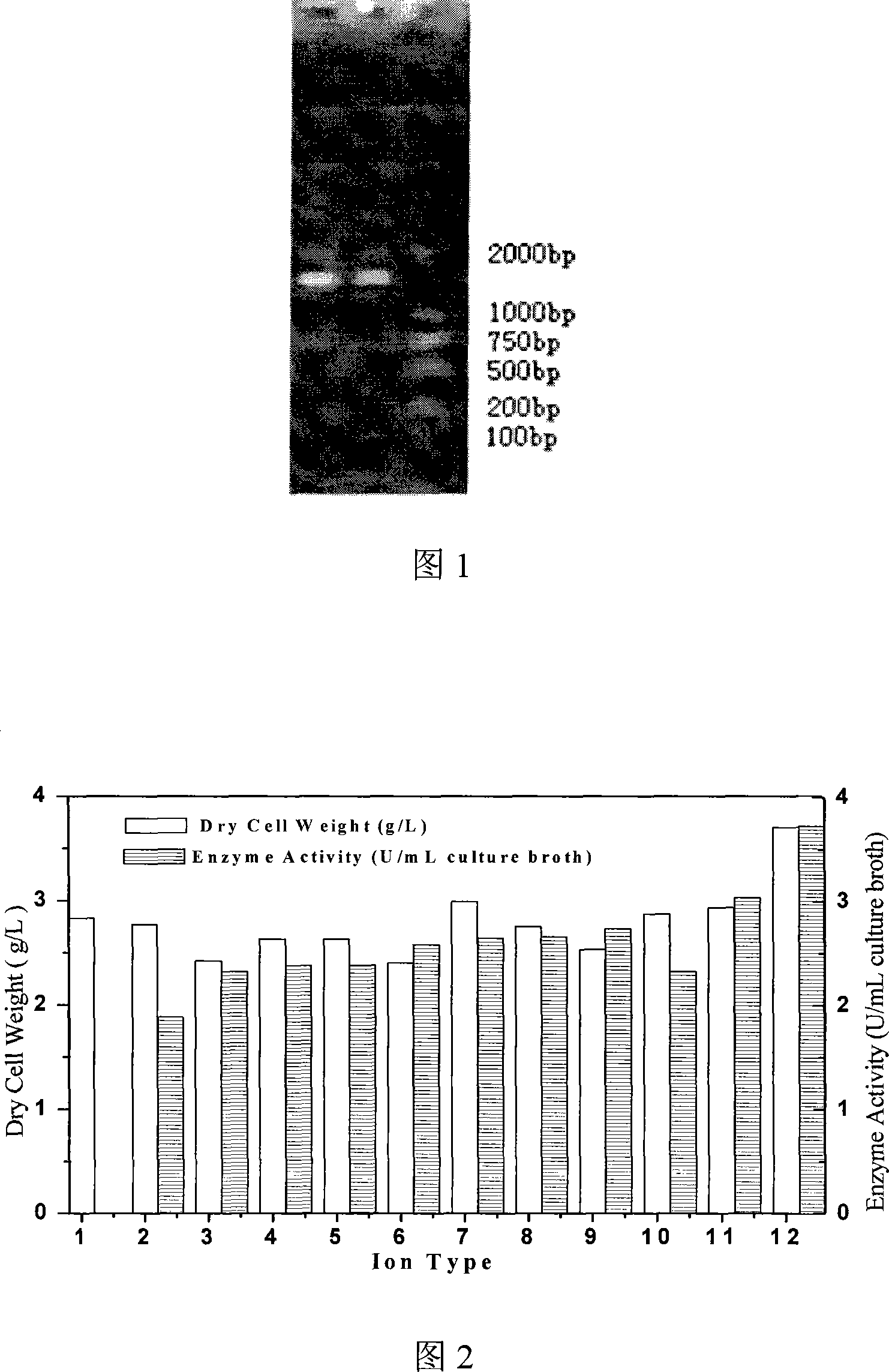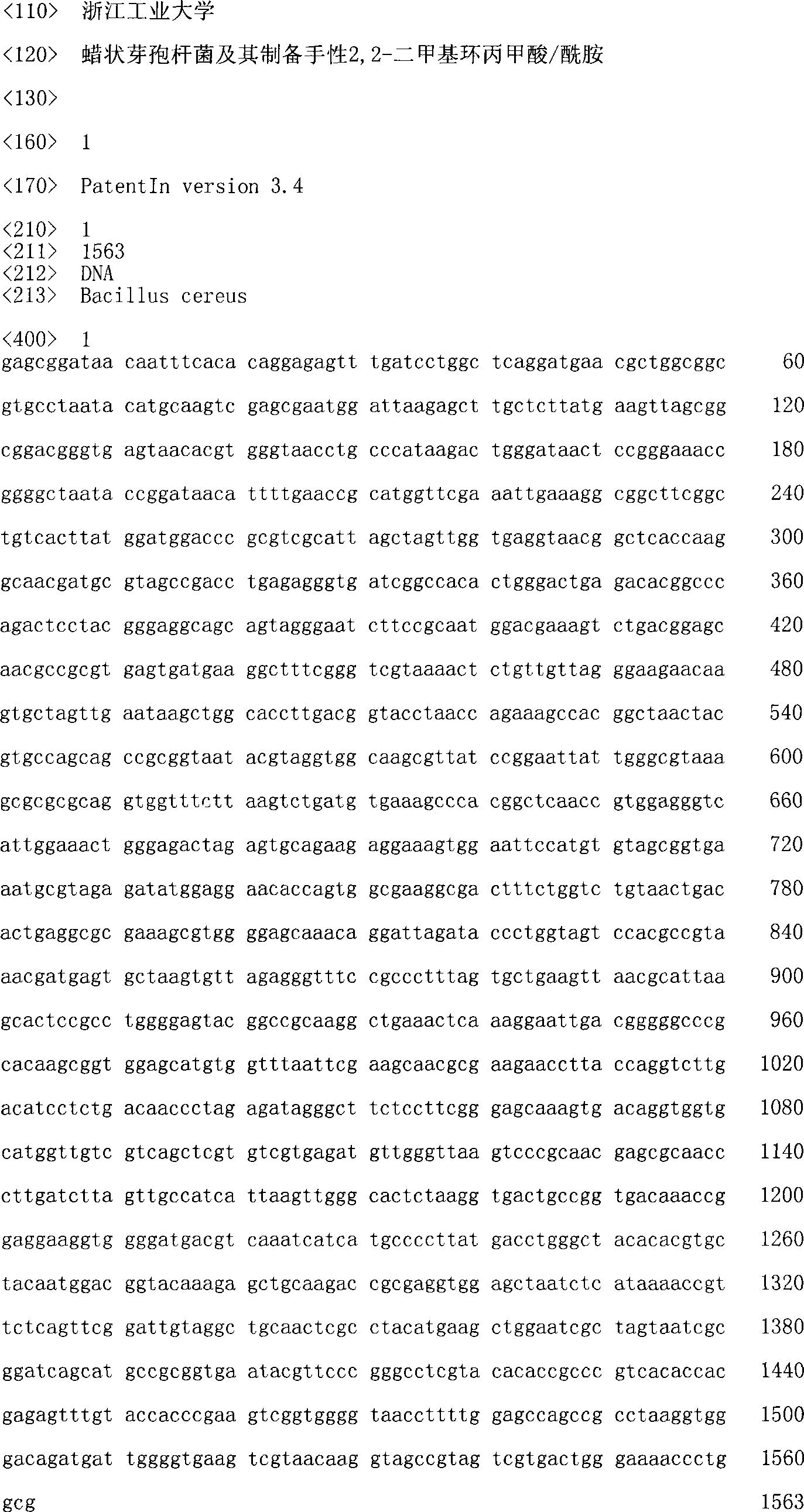Bacillus cercus and chiral 2,2-dimethyl cyclopropanecarboxylic acid/cyclopropancarboxamid prepared from the same
A technology of dimethylcyclopropanecarboxamide and dimethylcyclopropanecarboxylic acid is applied in the field of Bacillus cereus and the preparation of chiral 2,2-dimethylcyclopropanecarboxylic acid/amide, which can solve the problem of expensive chiral catalysts , environmental hazards, etc.
- Summary
- Abstract
- Description
- Claims
- Application Information
AI Technical Summary
Problems solved by technology
Method used
Image
Examples
Embodiment 1
[0087] Embodiment 1: the isolation of bacterial strain
[0088] Isolation of S-amidase-producing bacteria: Add 1 g of soil sample (from Zhejiang Province) and appropriate amount of glass beads to 9 mL of 0.85% normal saline, shake well to form a uniform soil suspension; draw 0.5 mL of soil suspension Inoculate 250mL Erlenmeyer flask with 30mL enrichment medium, place in 30°C, 150rpm shaker for 4 days, wait for enrichment solution to become turbid, transfer 0.5mL to fresh medium , and continue to cultivate for 4 days; after repeating this for 4 to 5 cycles, dilute the enrichment solution into multiple gradients, spread it on the separation plate, and obtain a single colony;
[0089] The enrichment medium uses 2,2-dimethylcyclopropanamide as the only nitrogen source, and the composition is as follows (final concentration): KH 2 PO 4 0.5g / L, K 2 HPO 4 0.5g / L, MgSO 4 ·7H 2 O 0.5g / L, FeSO 4 ·7H 2 O0.03g / L, CaCl 2 0.03g / L, 2,2-Dimethylcyclopropylcarboxamide, 1.5g / L, pH 7.0,...
Embodiment 2
[0091] Embodiment 2: the cultivation of bacterial strain
[0092] Slant medium composition (final concentration): beef extract 5g / L, peptone 10g / L, NaCl 5g / L, agar 18g / L, prepared with tap water;
[0093] Pick a single colony of CCTCC No: M 207139 on the plate, inoculate it on the slant, culture it in a constant temperature incubator at 30°C for 48 hours, and store it in a refrigerator at 4°C for later use.
Embodiment 3
[0094] Embodiment 3: the acquisition of wet fungus cells
[0095] Medium preparation: glucose 15.8g, yeast powder 17.89g, 2,2-dimethylcyclopropanamide 3.47g, KH 2 PO 4 1g, K 2 HPO 4 1g, MgSO 4 ·7H 2 O 0.2g, FeSO 4 ·7H 2 O 0.03g; make up to 1L with tap water, pH 7.0;
[0096] In a 250ml shake flask with 30% liquid volume, inoculate a ring of CCTCC No: M 207139, shake and cultivate at 20°C and 150rpm for 72 hours; after the cultivation, the fermentation broth is centrifuged and washed twice with normal saline, and the wet bacterial cells are collected. The water content is 80%, suspended in 50mM, pH 7.8 phosphate buffer solution, and the bacterial suspension with a wet bacterial cell content of 0.5g / mL is obtained for future use.
PUM
| Property | Measurement | Unit |
|---|---|---|
| diameter | aaaaa | aaaaa |
Abstract
Description
Claims
Application Information
 Login to View More
Login to View More - R&D
- Intellectual Property
- Life Sciences
- Materials
- Tech Scout
- Unparalleled Data Quality
- Higher Quality Content
- 60% Fewer Hallucinations
Browse by: Latest US Patents, China's latest patents, Technical Efficacy Thesaurus, Application Domain, Technology Topic, Popular Technical Reports.
© 2025 PatSnap. All rights reserved.Legal|Privacy policy|Modern Slavery Act Transparency Statement|Sitemap|About US| Contact US: help@patsnap.com



